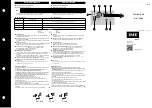
Date Code 20020129
Setting the Relay
6-5
SEL-387E Instruction Manual
Winding 1 elements. Also, because tertiary circuits normally are short, probably only including
the substation buses and auxiliary equipment, reports on faults of any kind would be of great
interest.
The LER setting defines how long the overall report should be: 15, 29, or 60 cycles. The related
setting PRE defines how much of that length should be “pre-trigger,” and can be set from one
cycle to LER-1 cycles. We have selected the standard SEL report length of 15 for LER, with
PRE set at 4, giving 15 – 4=11 cycles of fault data. This is probably long enough to capture the
entire event, for trips by high-speed elements (87R, 87U, 50Pxx), but may not be long enough
for inverse-time trips. Because any trip will generate an Event Report, inverse-time trips may be
captured on two reports, one generated by element pickup and the other by the eventual trip.
Event Report settings are Global settings, accessible with a
SET G
command from a
communications port.
System Frequency (NFREQ) and Phase Rotation (PHROT)
The relay settings NFREQ and PHROT establish your basic system parameters for the SEL-387E
Relay.
1. Set NFREQ equal to the nominal power system operating frequency, either 50 Hz or 60 Hz.
2. Set PHROT to the power system phase rotation, either ABC or ACB.
These are Global settings, set after issuing a
SET G
command from a communications port.
Phase Potential Connection (DELTA_Y)
Select D if your potential transformers (PTs) are connected in open-delta. A setting of Y enables
the phase-ground voltage elements and enables display of three-phase and single-phase power
measurements in the meter report. A setting of D removes the
»
3 multiplication from the V/Hz
calculation that normally accounts for the difference between phase-to-neutral and phase-to-
phase voltages, disables and hides the phase-ground voltage elements, and removes single-phase
power measurements from the meter report.
Measured phase-to-phase voltages (VAB, VCB) from open-delta PTs are converted to calculated
phase-to-phase voltages (VAB, VBC, VCA) when DELTA_Y=D. These voltages are used for
various elements. The meter report converts the calculated phase-to-phase voltages (VAB, VBC,
VCA) into phase-to-neutral voltages (VA, VB, VC) by dividing the phase-to-phase voltages by
»
3. Phase-to-phase voltages can only be converted to phase-to-neutral voltages using the
»
3
factor when the system is balanced. Relabel VA, VB, and VC to VAB, VBC, and VCA,
respectively, using the
SET G
command and increase your PTR setting by a factor of
»
3 using
the
SET
command to display phase-to-phase voltages rather than phase-to-neutral voltages.
However, increasing the PTR by
»
3 also increases the V/Hz measurement by
»
3. To adjust for
this V/Hz increase, multiply the VNOM setting by
»
3. For example, consider the following
default settings:
VNOM =
230
PTR
= 2000
















































